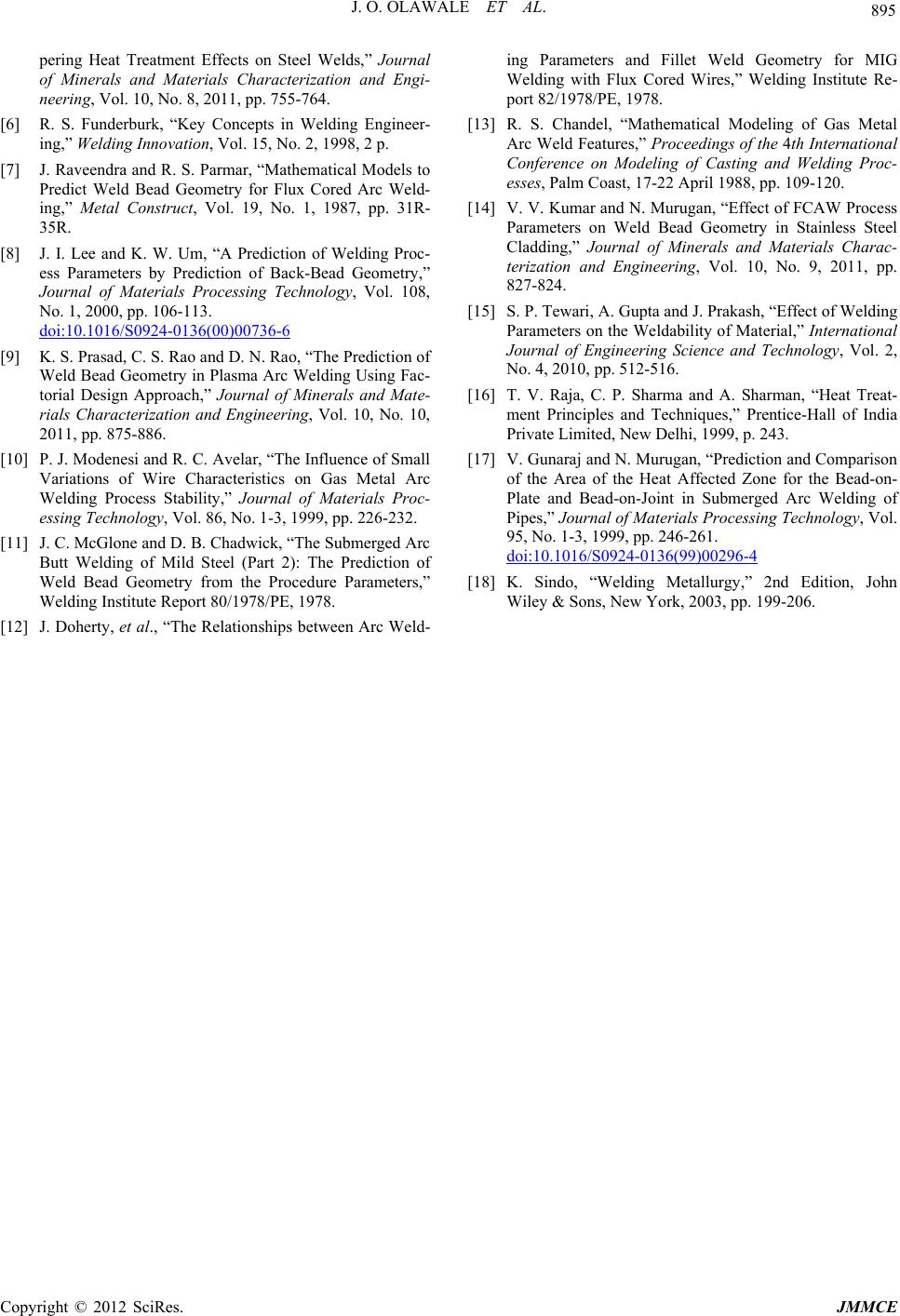
J. O. OLAWALE ET AL. 895
pering Heat Treatment Effects on Steel Welds,” Journal
of Minerals and Materials Characterization and Engi-
neering, Vol. 10, No. 8, 2011, pp. 755-764.
[6] R. S. Funderburk, “Key Concepts in Welding Engineer-
ing,” Welding Innovation, Vol. 15, No. 2, 1998, 2 p.
[7] J. Raveendra and R. S. Parmar, “Mathematical Models to
Predict Weld Bead Geometry for Flux Cored Arc Weld-
ing,” Metal Construct, Vol. 19, No. 1, 1987, pp. 31R-
35R.
[8] J. I. Lee and K. W. Um, “A Prediction of Welding Proc-
ess Parameters by Prediction of Back-Bead Geometry,”
Journal of Materials Processing Technology, Vol. 108,
No. 1, 2000, pp. 106-113.
doi:10.1016/S0924-0136(00)00736-6
[9] K. S. Prasad, C. S. Rao a nd D. N. Rao, “The Prediction of
Weld Bead Geometry in Plasma Arc Welding Using Fac-
torial Design Approach,” Journal of Minerals and Mate-
rials Characterization and Engineering, Vol. 10, No. 10,
2011, pp. 875-886.
[10] P. J. Modenesi and R. C. Avelar, “The Influence of Smal l
Variations of Wire Characteristics on Gas Metal Arc
Welding Process Stability,” Journal of Materials Proc-
essing Technology, Vol. 86, No. 1-3, 1999, pp. 226-232.
[11] J. C. McGlone and D. B. Chadwick, “The Submerged Arc
Butt Welding of Mild Steel (Part 2): The Prediction of
Weld Bead Geometry from the Procedure Parameters,”
Welding Institute Report 80/1978/PE, 1978.
[12] J. Doherty, et al., “The Relationships between Arc Weld-
ing Parameters and Fillet Weld Geometry for MIG
Welding with Flux Cored Wires,” Welding Institute Re-
port 82/1978/PE, 1978.
[13] R. S. Chandel, “Mathematical Modeling of Gas Metal
Arc Weld Features,” Proceedings of the 4th International
Conference on Modeling of Casting and Welding Proc-
esses, Palm Coast, 17-22 April 1988, pp. 109-120.
[14] V. V. Kumar and N. Murugan, “Effect of FCAW Process
Parameters on Weld Bead Geometry in Stainless Steel
Cladding,” Journal of Minerals and Materials Charac-
terization and Engineering, Vol. 10, No. 9, 2011, pp.
827-824.
[15] S. P. Tewari, A. Gupta and J. Prakash, “Effect of Welding
Parameters on the Weldability of Material,” International
Journal of Engineering Science and Technology, Vol. 2,
No. 4, 2010, pp. 512-516.
[16] T. V. Raja, C. P. Sharma and A. Sharman, “Heat Treat-
ment Principles and Techniques,” Prentice-Hall of India
Private Li mi ted, New Delhi, 1999, p. 243.
[17] V. Gunaraj and N. Murugan, “Prediction and Comparison
of the Area of the Heat Affected Zone for the Bead-on-
Plate and Bead-on-Joint in Submerged Arc Welding of
Pipes,” Journal of Materials Processing Technology, Vol.
95, No. 1-3, 1999, pp. 246-261.
doi:10.1016/S0924-0136(99)00296-4
[18] K. Sindo, “Welding Metallurgy,” 2nd Edition, John
Wiley & Sons, New York, 2003, pp. 199-206.
Copyright © 2012 SciRes. JMMCE